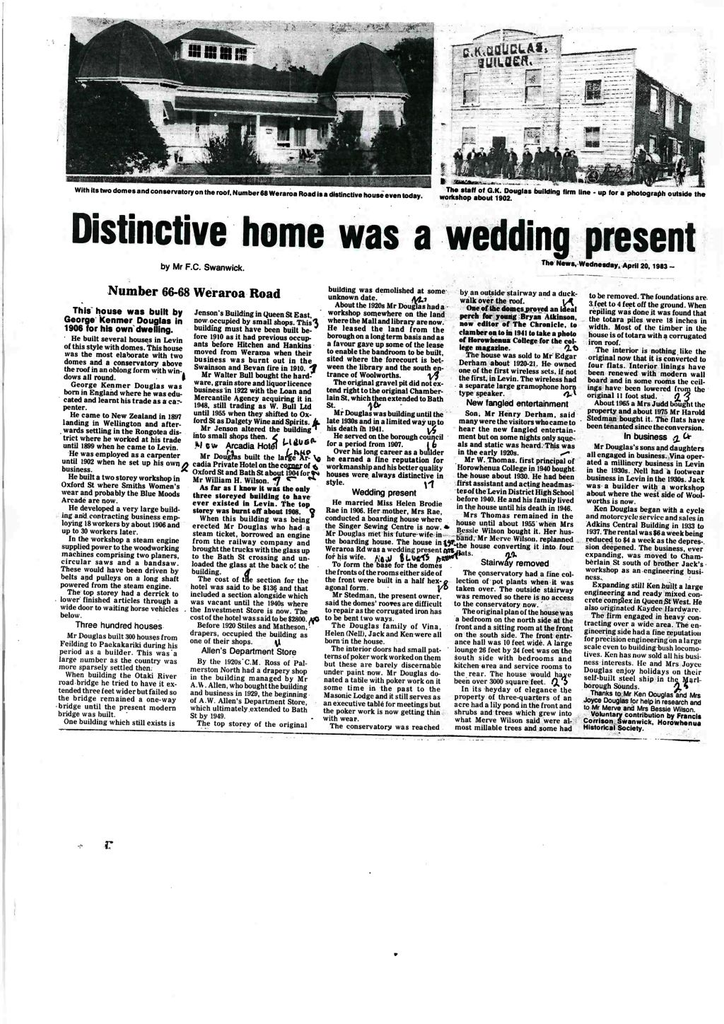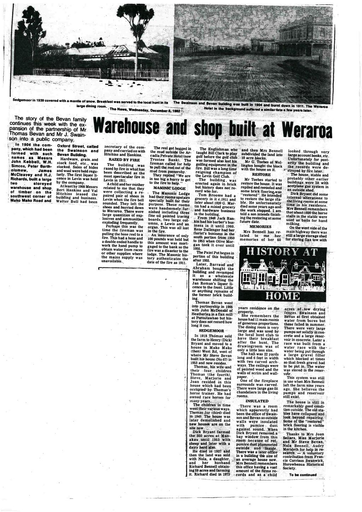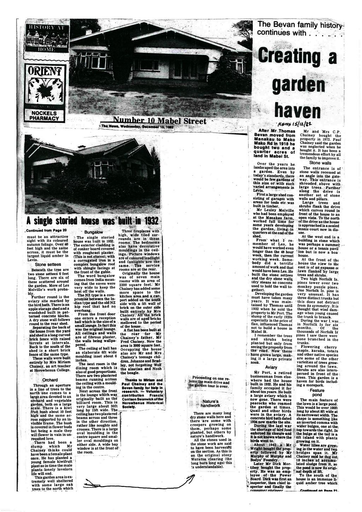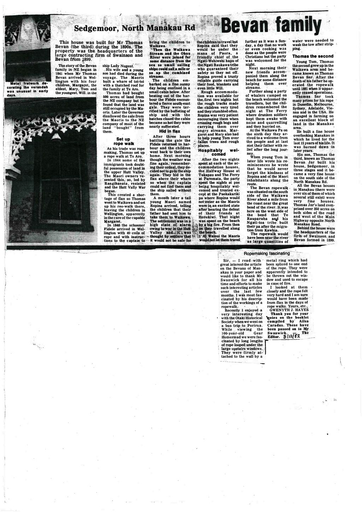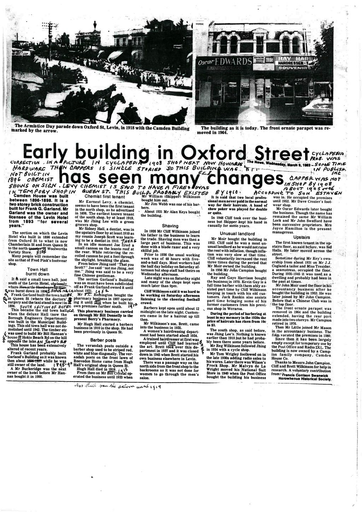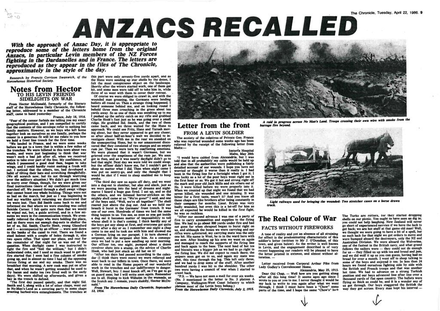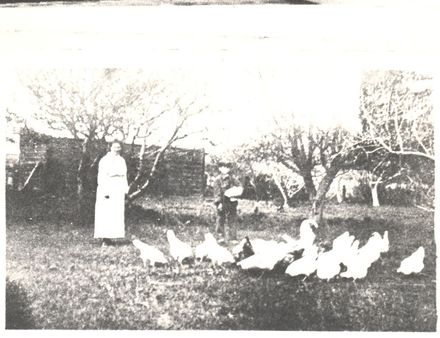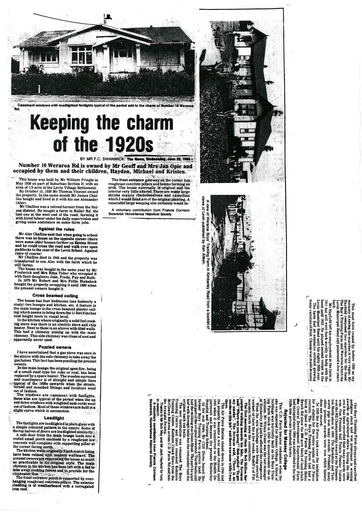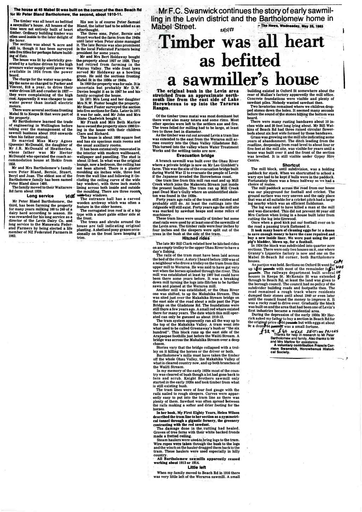66-68 Weraroa Road
- Description
 This house was built by George Kenmer Douglas in 1906 for his own dwelling.
This house was built by George Kenmer Douglas in 1906 for his own dwelling.
He built several houses in Levin of this style with domes. This house was the most elaborate with two domes and a conservatory above the roof in an oblong form with windows all round.
George Kenmer Douglas was born in England where he was educated and learnt his trade as a carpenter.
He came to New Zealand in 1897 landing in Wellington and afterwards settling in the Rongotea district where he worked at his trade until 1899 when he came to Levin.
He was employed as a carpenter until 1902 when he set up his own business. He built a two storey workshop in Oxford Street where Smiths Women’s wear and probably the Blue Moods Arcade are now.
 He developed a very large building and contracting business employing 18 workers by about 1906 and up to 30 workers later.
He developed a very large building and contracting business employing 18 workers by about 1906 and up to 30 workers later. In the workshop a steam engine supplied power to the woodworking machines comprising two planers, circular saws and a bandsaw. These would have been driven by belts and pulleys on a long shaft powered from the steam engine.
The top storey had a derrick to lower finished articles through a wide door to waiting horse vehicles below.
Three hundred houses
Mr Douglas built 300 houses from Feilding to Paekakariki during his period as a builder. This was a large number as the country was more sparsely settled then.
When building the Otaki River road bridge he tried to have it extended three feet wider but failed so the bridge remained a one-way bridge until the present modern bridge was built.
One building which still exists is Jenson’s Building in Queen St East, now occupied by small shops. This building must have been built before 1910 as it had previous occupants before Hitchen and Hankins moved from Weraroa when their business was burnt out in the Swainson and Bevan fire in 1910.
Mr Walter Bull bought the hardware, grain store and liquor licence business in 1922 with the Loan and Mercantile Agency acquiring it in 1948, still trading as W. Bull Ltd until 1955 when they shifted to Oxford St as Dalgety Wine and Spirits.
Mr Jenson altered the building into small shops then.
Arcadia Hotel
Mr Douglas built the large Arcadia Private Hotel on the corner of Oxford St and Bath St about 1906 for Mr William H. Wilson.
As far as I know it was the only three storied building to have ever existed in Levin. The top storey was burnt off about 1908.
When this building was being erected Mr Douglas who had a steam ticket, borrowed an engine from the railway company and bought the trucks with the glass up to the Bath St crossing and unloaded the glass at the back of the building.
The cost of the section for the hotel was said to be $136 and that included a section alongside which was vacant until 1940s where the Investment Store is now. The cost of the hotel was said to be $2800.
Before 1920 Stiles and Matheson, drapers, occupied the building as one of their shops.
Allen’s Department Store
By the 1920’s C.M. Ross of Palmerston North had a drapery shop in the building managed by Mr A.W. Allen, who bought the building and business in 1929, the beginning of A.W. Allen’s Department Store, which ultimately extended to Bath St by 1949.
The top storey of the original building was demolished at some unknown date.
About the 1920s Mr Douglas had a workshop somewhere on the land where the Mall and library are now. He leased the land from the borough on a long term basis and as a favour gave up some of the lease to enable the bandroom to be built, sited where the forecourt is between the library and the south entrance of Woolworths.
The original gravel pit did not extend right to the original Chamberlain St, which then extended to Bath St.
Mr Douglas was building until the late 1930s and in a limited way up to his death in 1941.
He served on the borough council for a period from 1907.
Over his long career as a builder he earned a fine reputation for workmanship and his better quality houses were always distinctive in style
Wedding present
He married Miss Helen Brodie Rae in 1906. Her mother, Mrs Rae, conducted a boarding house where the Singer Sewing Centre is now. Mr Douglas met his future wife in the boarding house. The house in Weraroa Road was a wedding present for his wife.
To form the base for the domes the fronts of the rooms either side of the front were built in half hexagonal form.
Mr Stedman, the present owner, said the domes’ rooves are difficult to repair as the corrugated iron has to be bent two ways.
The Douglas family of Vina, Helen (Nell) Jack and Ken were all born in the house.
The interior doors had small patterns of poker work worked on them but these are barely discernable under paint now. Mr Douglas donated a table with poker work on it sometime in the past to the Masonic Lodge and it still serves as an executive table for meetings but the poker work is now getting thin with wear.
The conservatory was reached by an outside stairway and a duckwalk over the roof.
One of the domes proved an ideal perch for young Bryan Atkinson, now editor of The Chronicle, to clamber on to in 1941 to take a photo of Horowhenua College for the college magazine.
The house was sold to Mr Edgar Derham about 1920-21. He owned one of the first wireless sets, if not the first, in Levin. The wireless had a separate large gramophone horn type speaker.
New fangled entertainment
Son, Mr Henry Derham, said many were the visitors who came to hear the new fangled entertainment but on some nights only squeals and static was heard. This was the early 1920s.
Mr W. Thomas, first principal of Horowhenua College in 1940 bought the house about 1930. He had been first assistant and acting headmaster of the Levin District High School before 1940. He and his family lived in the house until his death in 1946.
Mrs Thomas remained in the house until about 1955 when Mrs Bessie Wilson bought it. Her husband, Mr Merve Wilson, replanned the house converting it into four flats.
Stairway removed
The conservatory had a fine collection of pot plants when it was taken over. The outside stairway was removed so there is no access to the conservatory now.
The original plan of the house was a bedroom on the north side at the front and a sitting room at the front on the south side. The front entrance hall was 10 feet wide.
A large lounge 26 feet by 24 feet was on the south side with bedrooms and kitchen area and service rooms to the rear. The house would have been over 3000 square feet.
In its heyday of elegance the property of three-quarters of an acre had a lily pond in the front and shrubs and trees which grew into what Merve Wilson said were almost millable trees and some had to be removed. The foundations are 3 feet to 4 feet off the ground. When repiling was done it was found that the totara piles were 18 inches in width. Most of the timber in the house is of totara with a corrugated iron roof.
The interior is nothing like the original now that it is converted into four flats. Interior linings have been renewed with modern wallboard and in some rooms the ceilings have been lowered from the original 11 foot stud.
About 1965 a Mrs Judd bought the property and about 1975 Mr Harold Stedman bought it. The flats have been tenanted since the conversion.
In business
Mr Douglas’s sons and daughters all engaged in business. Vina operated a millinery business in Levin in the 1930s. Nell had a footwear business in Levin in the 1930s.
Jack was a builder with a workshop about where the west side of Woolworths is now.
Ken Douglas began with a cycle and motorcycle service and sales in Adkins Central Building in 1933 to 1937. The rental was $6 a week being reduced to $4 a week as the depression deepened. The business, ever expanding, was moved to Chamberlain St south of brother Jack’s workshop as an engineering business.
Expanding still Ken built a large engineering and ready mixed concrete complex in Queen St West. He also originated Kaydee Hardware.
The firm engaged in heavy contracting over a wide area. The engineering side had a fine reputation for precision engineering on a large scale even to building bush locomotives. Ken has now sold all his business interests. He and Mrs Joyce Douglas enjoy holidays on their self-built steel ship in the Marlborough Sounds.
- - - - - - - - - - - - - - - - - - - - - - - - - - - - - - - - - - - - - - - - - - - - - - - - - - - - -- - - -- - - - - - - - - - - - - - - - - - - - - - - - - - - - - -
on 12 July 1997, The Chronicle ran the following item:
'Longtime Levin resident Joyce Douglas spotted a picture in The Chronicle's photography page earlier this month and recognised it as the boyhood home of her late husband, Ken. In a letter to the editor, Mrs Douglas outlined the history of the house and its builder.
The Chronicle (July 3) carried a page headed Focus on Photography which featured a house in Weraroa Road that carried the Caption "An architectural Oddity".
The oddity could have been through the eye of the beholder. Unless they were a qualified architect. It was only a personal point of view.
The following information may be of interest; the house was built in 1906, as a wedding present for his wife by the late George Sherman Douglas. It was a 15 room residence with poker work doors, brass doorstep and a conservatory up top, set in spacious grounds with a lily pond on the front lawn. George Sherman and Helen Douglas had four children, 2 girls and 2 boys, all born in the northern wing of the house. I understand it was sold to a doctor, but over the years, different owners have made alterations to the house which is now occupied as flats.
The late Mr Douglas operated a business from his joinery factory which was situated in Oxford Street. He employed a staff of 40. The houses were made at his joinery works and transported to the site by a team of horses and drays, allowing six weeks to complete each project.
He was a man who took tremendous pride in his work and wad renowned for the quality of workmanship he produced. The 300 houses he built in the district carried distinct features of some special interest. Some of his older contributions to Levin were: The Arcadia Hotel, a three story building on the eastern corner of Bath and Oxford Streets.
The Masonic Temple, on the comer of Bristol and Salisbury Streets, the swing bridge access to the water works and the old bridge on the main highway over the Otaki River.
In obtaining the contract for that bridge he begged authorities to make the bridge 18 inches wider to allow two cars to pass. He was laughed at and told two cars would not meet on the bridge. Before that bridge was replaced just prior to the 1939 war, George Sherman witnessed long queues of cars waiting access to cross. Another contribution to the community was serving on the council at the turn of the century.
On retirement the joinery factory was converted into a shop, G M Ross and Co., managed by Mr A W Allen who later purchased the business.
All Mr Douglas's family and two grandchildren served the district by entering business in their own right. The youngest son made 41 years of service to the district with his engineering business and staff of 60.
This family have certainly contributed to the development and history of Levin and Districts over the years.
Identification
- Date
- April 20, 1983
Taxonomy
- Community Tags

